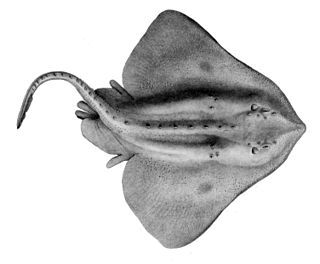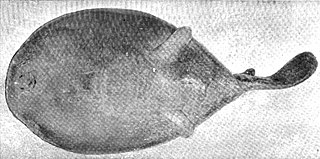
Chondrichthyes is a class of jawed fish that contains the cartilaginous fish or chondrichthyians, which all have skeletons primarily composed of cartilage. They can be contrasted with the Osteichthyes or bony fish, which have skeletons primarily composed of bone tissue. Chondrichthyes are aquatic vertebrates with paired fins, paired nares, placoid scales, conus arteriosus in the heart, and a lack of opecula and swim bladders. Within the infraphylum Gnathostomata, cartilaginous fishes are distinct from all other jawed vertebrates.

The Gymnotiformes are an order of teleost bony fishes commonly known as Neotropical knifefish or South American knifefish. They have long bodies and swim using undulations of their elongated anal fin. Found almost exclusively in fresh water, these mostly nocturnal fish are capable of producing electric fields to detect prey, for navigation, communication, and, in the case of the electric eel, attack and defense. A few species are familiar to the aquarium trade, such as the black ghost knifefish, the glass knifefish, and the banded knifefish.

Skates are cartilaginous fish belonging to the family Rajidae in the superorder Batoidea of rays. More than 150 species have been described, in 17 genera. Softnose skates and pygmy skates were previously treated as subfamilies of Rajidae, but are now considered as distinct families. Alternatively, the name "skate" is used to refer to the entire order of Rajiformes.

The electric rays are a group of rays, flattened cartilaginous fish with enlarged pectoral fins, composing the order Torpediniformes. They are known for being capable of producing an electric discharge, ranging from 8 to 220 volts, depending on species, used to stun prey and for defense. There are 69 species in four families.

An electric fish is any fish that can generate electric fields. Most electric fish are also electroreceptive, meaning that they can sense electric fields. The only exception is the stargazer family (Uranoscopidae). Electric fish, although a small minority of all fishes, include both oceanic and freshwater species, and both cartilaginous and bony fishes.

Narcinidae, or numbfishes, are a family of electric rays. They are bottom-dwelling cartilaginous fishes with large, rounded pectoral fin discs and long tails. They can produce an electric discharge for defense, from which their scientific name is derived.

Typhlonarke is a genus of sleeper ray in the family Narkidae, containing two poorly known species. The group is known for producing electric shocks for defense. Both species are deep-sea rays endemic to the waters off New Zealand. They are not to be confused with the blind electric rays of the genus Benthobatis.

In biology, the electric organ is an organ that an electric fish uses to create an electric field. Electric organs are derived from modified muscle or in some cases nerve tissue, and have evolved at least six times among the elasmobranchs and teleosts. These fish use their electric discharges for navigation, communication, mating, defence, and in strongly electric fish also for the incapacitation of prey.

The oval electric ray is a little-known species of sleeper ray in the family Narkidae. It is endemic to New Zealand, where it is generally found on the sea floor at a depth of 300–400 m (980–1,310 ft). Seldom exceeding 30 cm (12 in) in length, this species has a thick, oval pectoral fin disc and a short, stout tail with a single dorsal fin. It is blind, as its tiny eyes are covered by skin. Its pelvic fins are divided in two, with the anterior portion forming a limb-like appendage. These appendages likely allow the ray, which may not be able to swim at all, to "walk" along the bottom. The claspers of adult males extend beyond the disc. Polychaete worms are known to be part of its diet, and its reproduction is aplacental viviparous. It can produce an electric shock for defense. The International Union for Conservation of Nature presently lacks the data to assess its conservation status.
A blind fish is a fish without functional eyes. Most blind fish species are found in dark habitats such as the deep ocean, deep river channels and underground.
The Brazilian blind electric ray, is a species of fish in the family Narcinidae endemic to Brazil. Its natural habitat is open seas.

The marbled electric ray is a species of electric ray in the family Torpedinidae found in the coastal waters of the eastern Atlantic Ocean from the North Sea to South Africa. This benthic fish inhabits rocky reefs, seagrass beds, and sandy and muddy flats in shallow to moderately deep waters. It can survive in environments with very little dissolved oxygen, such as tidal pools. The marbled electric ray has a nearly circular pectoral fin disc and a muscular tail that bears two dorsal fins of nearly equal size and a large caudal fin. It can be identified by the long, finger-like projections on the rims of its spiracles, as well as by its dark brown mottled color pattern, though some individuals are plain-colored. Males and females typically reach 36–38 cm (14–15 in) and 55–61 cm (22–24 in) long respectively.

Members of the family Narkidae are commonly known as sleeper rays. They are restricted to the temperate and tropical Indo-West Pacific from South Africa to Japan to Indonesia, and are exclusively marine and are absent from freshwater habitats. They occur from the intertidal zone to the continental shelf and the upper continental slope to a depth of 350 meters, favoring soft-bottomed habitats.

Batoidea is a superorder of cartilaginous fishes, commonly known as rays. They and their close relatives, the sharks, comprise the subclass Elasmobranchii. Rays are the largest group of cartilaginous fishes, with well over 600 species in 26 families. Rays are distinguished by their flattened bodies, enlarged pectoral fins that are fused to the head, and gill slits that are placed on their ventral surfaces.

The blind electric ray is a little-known species of sleeper ray in the family Narkidae, endemic to New Zealand. It is found on the bottom, typically at a depth of 300–400 m (980–1,310 ft). Reaching 38 cm (15 in) in length, this species has a thin, nearly circular pectoral fin disc without visible eyes, and a short tail with a single dorsal fin. Its pelvic fins are divided in two, with the anterior portion forming a limb-like appendage; in males the claspers do not extend past the disc margin. A weak swimmer, the blind electric ray likely pushes itself along using its pelvic fins. It is known to feed on polychaete worms, and can defend itself with an electric shock. Reproduction is aplacental viviparous. The International Union for Conservation of Nature (IUCN) does not have enough information to assess the conservation status of this species.
Benthobatis marcida, the blind torpedo, is a species of electric ray most commonly found in the west–central area of the Atlantic Ocean. Like all electric rays, it can produce an electric shock that can be harmful to humans and other fish. It can grow up to 50 cm (20 in) long.
Benthobatis yangi, the Taiwanese blind electric ray, is a species of fish in the family Narcinidae endemic to Taiwan. Its natural habitat is the upper continental slopes of coastal waters.

Benthobatis moresbyi, commonly known as the dark blindray, dark blind ray, or the Indian blind numbfish, is an electric ray species in the family Narcinidae. Moresbyi, was the captan of R.I.M.S. Investigator, the vessel of Indian Navy for surveying deep-water, Therefore, the species recognized with the name Benthobatis moresbyi.












